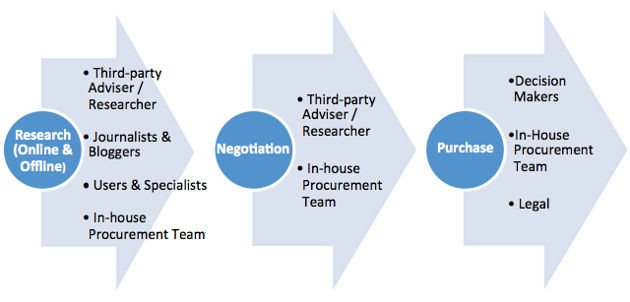Influencer marketing is not new. Brands have been using celebrities to influence buyers for decades—even B2B brands, such as Accenture, which partnered with golf superstar Tiger Woods, for example.
So why talk about influencer marketing now? It has become a hot topic because of the increased significance of social media in the business world. It has created a whole new set of influencers and also brought offline influencers to the online world—where the buyers are.
Yet, there's a set of influencers we tend to forget. They have offline influence on buyers but are not active on social media.
Should you use online methods to find them? Maybe. Should you use offline influencers to influence online buyers and decision makers? Maybe. Undoubtedly, though, you can strengthen your B2B influencer marketing performance by including both offline and online influencers.
In the B2B world, where deals are bigger and they can take months or even years to close, numerous people get involved in different phases of the purchase process.
Imagine a 55-year-old man who introduced himself to your sales team as a sourcing adviser from the customer side. Unfortunately, he is not active on social media, making your job difficult. And being a marketer means you are not part of the sales meetings. So how will you identify that adviser with the potential to influence the deal?
The starting point to identifying B2B influencers who are inactive on social media is mapping. Map the people (customer-side or third-party) who are often involved in the sales cycle. See the following image for a typical sales cycle with various stages and examples of people who get involved at each phase:

B2B sales cycle and customer-side people involved at each stage
To map accurately, you can adopt any or all of the following six methods:
1. Conduct internal research (online and offline). Start by looking at past deals to find the people who were involved at various stages. You can run an internal online and offline survey. To get better results, you can incentivize your sales and pre-sales teams to help you identify the key influencers. Those teams should want to help you with this activity because they do not have time to keep the influencers engaged, even though they know those people can change the buyer's perception about your company and your products and services.
2. Use CRM (customer relationships management) tools. Another way to map who is involved in the sales cycle is to include mandatory fields and questions in the CRM system that your sales and pre-sales teams use on a regular basis. Ask direct questions, and simply include relevant fields:
- Was there any influencer involved?
- If so, add details: Name; Company; Profile
3. Study deal and renewal databases. If your industry happens to have databases that include the details of deals signed with your competition, then source those. You will be surprised to see the kind of information you can get as part of that data. Most likely, you will be able to gather the names of the influencers involved in the deals—such as advisers, academicians, analysts, and researchers, to name a few.
4. Do online research. Yes, do online research to find the influencers who are not necessarily on social media channels or hardly use social media. Once you know the names of the companies your key influencers are from—through methods one and two—study those companies to find additional influencers. Even if your influencers are not online yet, you can often find their names and details from their employers' websites.
5. Revisit your marketing database. You may be surprised to discover how much data you already have about the influencers. For example, study the events database (sponsored and company-organized) to find influencers' names on the list of event attendees.
6. Attend key industry events. Most key influencers do not miss a chance to attend the right set of industry events that give them opportunities to meet, share, and learn from peers (and about peers, too). Spotting such influencers is crucial; they are probably the ones who are in the field walking and talking.
With combined online and offline research methods, you can identify those B2B influencers who are social media-shy. But don't try to influence them directly during a live sales cycle. That may work against your company. To influence an ongoing discussion, run subtle and indirect content marketing campaigns—online as well as offline. But, of course, before you can even start those campaigns, you need to identify all key influencers.




